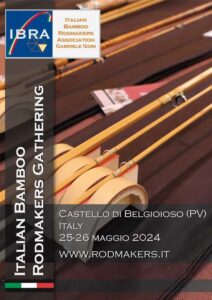By Dennis Skelmose Jensen, Denmark. October 2018.
When my father and I at the beginning of the eighties began to mount fly rods, we wondered why, that no matter what rod, action, material, brand or size, it was the same measurement for the location of the guides that went with it. We knew that this was wrong, but how do you prove this.
As Preben Torp Jacobsen and his friends were in the process of calculating split cane rods, we followed them closely. After many hours, a couple of computers and a number of mathematics books later we were getting there. By combining their calculations and ideas with our experience and ideas with fly rods, it was actually quite easy when you did it on a wall.
The basics are:
- A fly rods active part is the rods length minus the handle and reel seat.
- The active guides are the snake-guides, that loads the rod under the cast.
- The number of snake-guides are the same as the length of the rod in feet (+1). For longer rods 1 or 2 less.
- The stripping-guide is only for you, not for the bending. It is just a pleasant point to pick up the fly line.
- Ideal bend of the rod is when every fiber has the same load.

You have to use:
- A calculating machine
- A tape measure
- A piece of paper at the length of the rod and 1/3 of the rods active length.
- A small plastic bag.
- Many small weights.
- Two screws or nails.
- Tape.
- Black marker, correction pen / pencil.
- A wall.
How to:
- Prepare a piece of paper, same length as the fly rod and a width of 1/3 of the rods active part. Divide the width in equal parts in the full length of the paper with a pen. It shall be divided by the amount of snake-guides plus one (top-guide).
- Hang the rod horizontally on the wall with two screws. One just below the blank in front of the cork and another on top of the reel-seat.
- Attach the prepared paper horizontally behind the fly rod with tape. The upper edge of the paper should be in the middle of the blank by the cork.
- Tie in a small zip bag to the top guide and pour small weights in, until the top guide reaches the bottom edge of the paper.
- Mark the location on the blank, where the horizontal lines are crossing the rod blank.
- If the distance between the bottom snake-guide and the stripping-guide is too far, an additional snake-guide may be fitted between the two (by a too long distance the fly line will stick to the rod, learned by experience).
If the placement of the guides is not quite ideal (- some wants a guide at the ferrule), you can ad an extra guide or one less, when you divide the paper in equal parts.
Not two blanks are identical.
The experience told us, that there are not two identical blanks, and that the supplied schedules was mostly to no use. The rods we mounted was bye far better with this kind of eye placement. The rod blank will be compensated on the wall for stiff or soft parts in the blank.
After changing the guide-spacing of a rod from traditional to this way, people often didn’t believe, it was the same rod.
After more than 36 years this way of guide placement still counts. And this counts for all materials used for rod blanks.
Dennis Skelmose Jensen (c)
Last news is that I were brought in attention, that R. Barrud wrote a piece in “Trout and Salmon” back in September 1969 on nearly the same way of placing the guides as we did.
I have never seen or heard of it before, but hurrah we were not alone. We disagree only on small parts. He starts his part of deflection on the first shooting guide and he has not a calculation on how wide the deflection should be.
It is nice that you are not fighting windmills alone.
Dennis Skelmose Jensen. November 2018.

